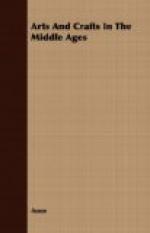In mediaeval art, however, the beauty of line, the sense of horror, and the voluptuous spirit, are all more or less subservient to the light-hearted buoyancy of a keen sense of fun. To illustrate this point, I wish to call the attention of the reader to the wit of the monastic scribes during the Gothic period. Who could look at the little animals which are found tucked away almost out of sight in the flowery margins of many illuminated manuscripts, without seeing that the artist himself must have been amused at their pranks, and intended others to be so? One can picture a gray-hooded brother, chuckling alone at his own wit, carefully tracing a jolly little grotesque, and then stealing softly to the alcove of some congenial spirit, and in a whisper inviting his friend to come and see the satire which he has carefully introduced: “A perfect portrait of the Bishop, only with claws instead of legs! So very droll! And dear brother, while you are here, just look at the expression of this little rabbit’s ears, while he listens to the bombastic utterance of this monkey who wears a stole!”
[Illustration: CARICATURE OF A BISHOP]
Such a fund of playful humour is seldom found in a single book as that embodied in the Tenison Psalter, of which only a few pages remain of the work of the original artist. The book was once the property of Archbishop Tenison. These few pages show to the world the most perfect example of the delicacy and skill of the miniaturist. On one page, a little archer, after having pulled his bow-string, stands at the foot of the border, gazing upwards after the arrow, which has been caught in the bill of a stork at the top of the page. The attitude of a little fiddler who is exhibiting his trick monkeys can hardly be surpassed by caricaturists of any time. A quaint bit of cloister scandal is indicated in an initial from the Harleian Manuscript, in which a monk who has been entrusted with the cellar keys is seen availing himself of the situation, eagerly quaffing a cup of wine while he stoops before a large cask. In a German manuscript I have seen, cuddled away among the foliage, in the margin, a couple of little monkeys, feeding a baby of their own species with pap from a spoon. The baby monkey is closely wrapped in the swathing bands with which one is familiar as the early trussing of European children. Satire and wrath are curiously blended in a German manuscript of the twelfth century, in which the scribe introduces a portrait of himself hurling a missile at a venturesome mouse who is eating the monk’s cheese—a fine Camembert!—under his very nose. In the book which he is represented as transcribing, the artist has traced the words—“Pessime mus, sepius me provocas ad iram, ut te Deus perdat.” ("Wicked mouse, too often you provoke me to anger—may God destroy thee!”)




